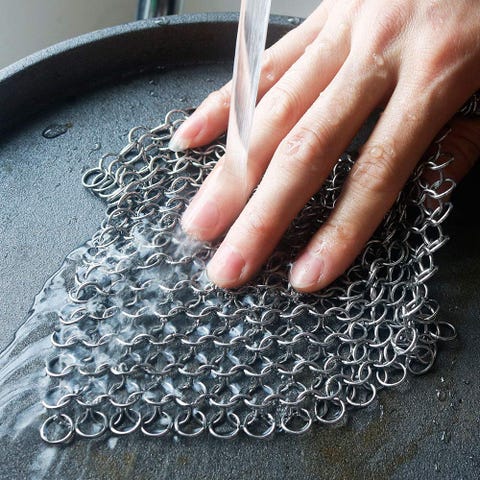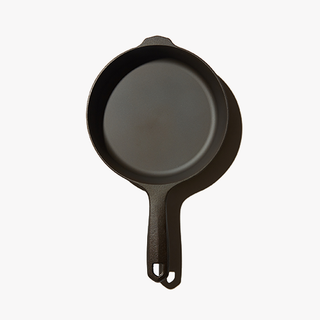How To Clean Cast Iron Skillet After Cooking
Cast-iron cookware has been around for so long that its origin is somewhat unclear. What we do know is that cast-iron cauldrons and kettles were first used for cooking in Asia more than 1,300 years ago! (Think air fryers will last that long?) And cast-iron pots and pans continued to be the number one choice of home cooks for many generations, until the 1960s. That's when nonstick cookware was introduced, and cast iron fell out of favor for their slick new Teflon cousins.
However, over the last decade or so, home cooks everywhere have rediscovered the many benefits of cast-iron cookware: First, cast iron is affordable, virtually indestructible, naturally nonstick, and has superior heat retention for even cooking and baking. Plus, it's available in a wide range of sizes and styles, including fry pans, grill pans, pots, skillets, waffle irons, and Dutch ovens. And finally, many home cooks are switching to cast iron as a healthy alternative to aluminum and traditional nonstick pans.
However, despite all the well-established benefits of cast iron, some people are still a bit reluctant to make the switch, and here's why: Cast iron has a reputation for being difficult to clean and quick to corrode, which isn't completely unfounded. That's because if it's not properly maintained and seasoned, cast iron will rust and food will stick. And to make things more complicated, there's much confusion about the best way to clean cast iron and whether or not you should use soap and water.
To clear up any confusion, provide some basic facts, and perhaps even convince you to try cast iron, I've broken down the care and maintenance of cast-iron cookware into three simple steps: Cleaning, Seasoning, and Storage. Follow these rules for how to clean cast-iron, and your pots and pans will remain in like-new condition for generations to come.
🔩 You like DIY projects. So do we. Let's build something together.
How to clean a cast-iron pan

Botefei
Most often you can clean a cast-iron pan by simply wiping it down with a dry paper towel or cotton dishcloth. If the pan is well seasoned, bits of burnt, stuck-on food will come right off. If any stubborn bits remain, scrape them off with a plastic spatula.
If dry wiping doesn't get the pan clean, use a scrubber and some water. Now, many people would shriek in horror at the thought of washing cast iron in water, mostly because of the increased risk of rusting, but when properly done, there's nothing to worry about.
Place the pan in the sink, add about ½ inch or so of warm water, then sprinkle in a half cup of coarse Kosher salt. Immediately scrub the pan with a stainless-steel scrubber or ordinary kitchen sponge. The salt will act as an abrasive to cut through food remnants. Rinse the pan clean with water, then—to prevent rusting—place the pan in 350º oven for 10 minutes until it's completely dry. (You can also dry it out on the cooktop.)
If you discover small rust spots on the pan, use the salt-scrub technique mentioned above to remove light surface corrosion. However, for heavily rusted cast iron, you'll need to be a little more aggressive: Fill the pan with hot, soapy water, then scrub with a steel-wool pad or, better yet, a metal chain-mail scrubber. If that doesn't work, take the pan outside and spray it with oven cleaner. Wait 10 minutes, then scrub off the rust with steel wool and soapy water. Thoroughly rinse the pan in clean water, dry it in an oven or on the cooktop, then wipe it down with oil.
Seasoning
It's important to season cast iron before using it for the very first time, and again after cleaning with hot, soapy water or oven cleaner. Seasoning makes the pan easy to clean, prevents rust, and keeps food from sticking.
Preheat the oven to 350 degrees Fahrenheit. Wipe down the pan with vegetable oil, then pop it into the hot oven for one full hour. Using a potholder, remove the pan, let it cool slightly, then rub a bit more oil into the warm pan. Wait a couple of minutes, then wipe down the pan with a dry paper towel.
Using a potholder, remove the pan from the oven and allow it to cool slightly, just five minutes or so. Then, while it's still warm, drizzle into the pan a little flaxseed oil, soybean oil, or other neutral-flavor vegetable oil. (Don't use olive oil or bacon fat, which can turn rancid.) Fold a paper towel into a small square and use it to wipe the oil into the surface of the cast-iron pan.
To prevent burning your fingers, hold the folded paper wad with a pair of tongs. Wait another couple of minutes, then use a second paper towel to remove any remaining oil from the pan.
Storage
The last, but no less important, rule is to always thoroughly dry cast-iron cookware before you store it away. Even the slightest bit of dampness will cause the pan to rust, which is why cast iron rusts more easily in summer than in winter. In fact, it's smart to place a paper towel into the pan to absorb any excess moisture or humidity.
Cast Iron Pans and Gear

Cast-Iron Cleaner
A chain-mail cleaning pad is the very best tool for keeping your cast-iron pans in great shape.

Field Cast Iron Skillet
The Field Company raised more than $1.6 million on Kickstarter to bring to market a lightweight, smooth, and pre-seasoned cast iron skillet.

Cast Iron 12-Inch Skillet
Lodge dickssportinggoods.com
$29.99
Lodge is classic. Though the name says "seasoned," the pan is by no means non-stick out of the box.

Signature Iron Handle Skillet
Le Creuset chefsfirst.com
$547.99
Thanks to the pan's black enamel surface, Le Creuset's cast-iron skillet is fairly non-stick—not to mention super smooth.
Now Watch This:
Joseph Truini Joe is a former carpenter and cabinetmaker who writes extensively about remodeling, woodworking, and tool techniques.
This content is created and maintained by a third party, and imported onto this page to help users provide their email addresses. You may be able to find more information about this and similar content at piano.io
How To Clean Cast Iron Skillet After Cooking
Source: https://www.popularmechanics.com/home/interior-projects/a27703968/how-to-clean-a-cast-iron-pan/
Posted by: hilliardpentor.blogspot.com

0 Response to "How To Clean Cast Iron Skillet After Cooking"
Post a Comment